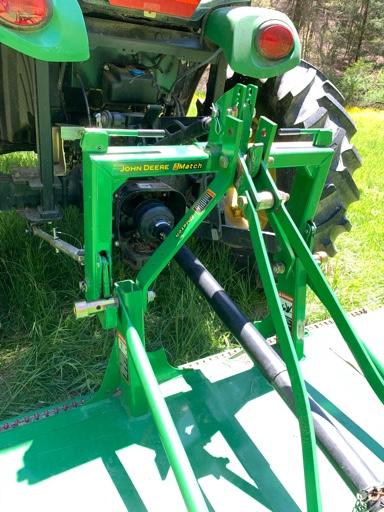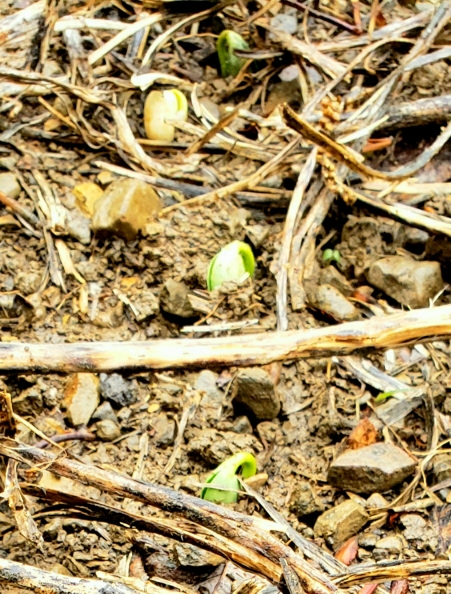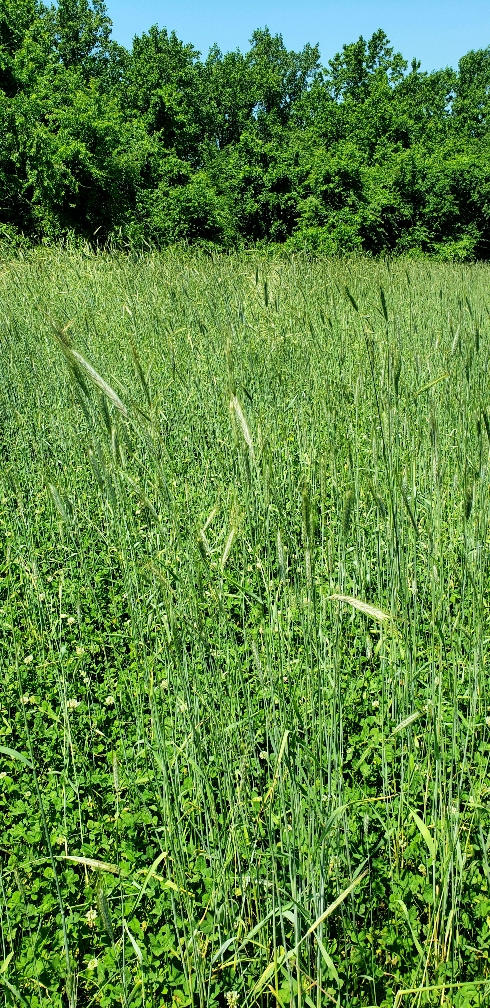You are using an out of date browser. It may not display this or other websites correctly.
You should upgrade or use an alternative browser.
You should upgrade or use an alternative browser.
Keystone Krops
- Thread starter Mennoniteman
- Start date
Mennoniteman
Well-Known Member
Yup, counted every single one. (well, theoretically by extrapolation) and wiped each one clean with a rag, can't plant dusty seed, you knowDid you count them?? Speed does kill, I'm guilty of getting n a hurry also which is why my bushhog is sitting in the field because I didn't replace a clip I had noticed was well worn. Good thread as always.
Which clip?
dogghr
Well-Known Member
Yup, counted every single one. (well, theoretically by extrapolation) and wiped each one clean with a rag, can't plant dusty seed, you know
Which clip?
I have a quick hitch attachment on tractor so I removed the sprayer in the upper field. Then hooked up bushhog. I dropped lynch pin/ the kind that slides thru hole and ring flips down to lock things n place, and couldn’t find it in weeds. So instead of heading to barn for another I used a battered undersized for the job hitch pin clip/ the kind that just slides thru hole and snaps n valley.
Worked good for an Hour then evidently fatigued and snapped allowing hog to slip off that side. Not sure how exactly but I was in a hurry. Disconnected it and went to barn and went home. I’ll be back Saturday. Speed /shortcuts kills time. Sometimes.
Sent from my iPhone using Tapatalk
MarkDarvin
Well-Known Member
You must have oats coming up through clover already, no?
Mennoniteman
Well-Known Member
Thanks for asking.You must have oats coming up through clover already, no?
Although my drilling oats into clover in early spring was a great success over the course of the past two years I didn't do it this spring, because that was phase one of a three phase ladino clover experiment, and since I proved to myself that I works, I am now embarking on phase two.
My thought is that clover and grains are the key to that mythical perpetual multi-component year-round food plot that no one has invented yet, and that's why I keep testing and evaluating different combinations.
ZONE 6B CLOVER EXPERIMENTS:
Phase one was drilling early oats into existing ladino clover before the clover has started growing in the spring. The benefits: balancing carbon/nitrogen and feeding deer oat heads during the summer. RESULTS: VERY SUCCESSFUL Pros: Clover looks beautiful with that straw mulch to feed on. Deer ate oat heads all summer. Cons: Don't really need more summer deer feed, we need winter deer feed.
Phase two is to spray the clover with herbicide in early spring (which I did), and then do a throw and mow in late summer with rye. The rye balances carbon and feeds deer over winter, growing into straw mulch the following spring and summer. Goals: An early spring slot to spray the clover for grass weeds and a summer perrenial clover plot with a rye component to feed deer over winter when the clover is dormant. (I did one acre last year with some early success, need higher rye seeding rates, I'm doing ten acres this year.)
Future Phase three coming up will be drilling early oats into existing ladino clover before the clover has started growing in the spring and then do a throw and mow in late summer with rye (essentially a combination of phase one and two). Phase 3 will be a no spray perennial clover plot with a semi-permanent dual small grain component to control weeds. The plan is to have a good stand of weed-free ladino clover to get started. Goals; winter and summer deer feed in a dual species plot (clover& grain) The big question that I need to work out is how to transition from the winter rye back into spring oats without spraying...
Mennoniteman
Well-Known Member
Lynch pins are the best/ worst pins ever made, they seem to get lost oftener than Joe B. in the white house. Quick hitch would be a farmall? An interesting note; for profit farmers are getting away from 3-point hitch equipment, it's technology that came and went, to much time spent hooking up, equipment is too close to the tractor, and too much that can go wrong. Sprayers, mowers, planters, tillage equipment, etc. are mostly pull type for the bigger farmers.I have a quick hitch attachment on tractor so I removed the sprayer in the upper field. Then hooked up bushhog. I dropped lynch pin/ the kind that slides thru hole and ring flips down to lock things n place, and couldn’t find it in weeds. So instead of heading to barn for another I used a battered undersized for the job hitch pin clip/ the kind that just slides thru hole and snaps n valley.
Worked good for an Hour then evidently fatigued and snapped allowing hog to slip off that side. Not sure how exactly but I was in a hurry. Disconnected it and went to barn and went home. I’ll be back Saturday. Speed /shortcuts kills time. Sometimes.
Sent from my iPhone using Tapatalk

MarkDarvin
Well-Known Member
Thanks for asking.
Although my drilling oats into clover in early spring was a great success over the course of the past two years I didn't do it this spring, because that was phase one of a three phase ladino clover experiment, and since I proved to myself that I works, I am now embarking on phase two.
My thought is that clover and grains are the key to that mythical perpetual multi-component year-round food plot that no one has invented yet, and that's why I keep testing and evaluating different combinations.
ZONE 6B CLOVER EXPERIMENTS:
Phase one was drilling early oats into existing ladino clover before the clover has started growing in the spring. The benefits: balancing carbon/nitrogen and feeding deer oat heads during the summer. RESULTS: VERY SUCCESSFUL Pros: Clover looks beautiful with that straw mulch to feed on. Deer ate oat heads all summer. Cons: Don't really need more summer deer feed, we need winter deer feed.
Phase two is to spray the clover with herbicide in early spring (which I did), and then do a throw and mow in late summer with rye. The rye balances carbon and feeds deer over winter, growing into straw mulch the following spring and summer. Goals: An early spring slot to spray the clover for grass weeds and a summer perrenial clover plot with a rye component to feed deer over winter when the clover is dormant. (I did one acre last year with some early success, need higher rye seeding rates, I'm doing ten acres this year.)
Future Phase three coming up will be drilling early oats into existing ladino clover before the clover has started growing in the spring and then do a throw and mow in late summer with rye (essentially a combination of phase one and two). Phase 3 will be a no spray perennial clover plot with a semi-permanent dual small grain component to control weeds. The plan is to have a good stand of weed-free ladino clover to get started. Goals; winter and summer deer feed in a dual species plot (clover& grain) The big question that I need to work out is how to transition from the winter rye back into spring oats without spraying...
I had u pegged as a quack, but I had no idea you were that far gone. Welcome to the club!
For your question, swap out your rye for awnless winter wheat. Kill all 7 birds with one stone, and less trips across the field.
Proper credit to Catscratch for discovering that stuff.
Sent from my iPhone using Tapatalk
DocHolladay
Well-Known Member
Lynch pins are the best/ worst pins ever made, they seem to get lost oftener than Joe B. in the white house. Quick hitch would be a farmall? An interesting note; for profit farmers are getting away from 3-point hitch equipment, it's technology that came and went, to much time spent hooking up, equipment is too close to the tractor, and too much that can go wrong. Sprayers, mowers, planters, tillage equipment, etc. are mostly pull type for the bigger farmers.

I call them Sunday pins. If one gets your finger, you’ll need to go to church on Sunday. They’ll make a preacher cuss.
Sent from my iPhone using Tapatalk
dogghr
Well-Known Member
No shortcuts this time. Before I just had a home made sleeve w a clip. I have these on my no longer used rotitiller. Better setup but I was trying save $30. Stupid. But my cheap fix worked for 12 years. Farmer has to cut costs somehow.

Sent from my iPhone using Tapatalk

Sent from my iPhone using Tapatalk
Mennoniteman
Well-Known Member
I now realize that you said "quick hitch", and it wasmy brain that read "fast hitch", the only difference is modern v.s old fashioned. I have never used a quick hitch, what's the pros and cons? Half my equipment is 3-point and half is pull behind, so I'm wondering how it would work for me.No shortcuts this time. Before I just had a home made sleeve w a clip. I have these on my no longer used rotitiller. Better setup but I was trying save $30. Stupid. But my cheap fix worked for 12 years. Farmer has to cut costs somehow.

Sent from my iPhone using Tapatalk
Mennoniteman
Well-Known Member
Titan forage beans have germinated, and are emerging 10 days after planting. The first five days were dry, prolonging emergence.


deer patch
Well-Known Member
Glad you have germination but that seems early for your area. What’s your soil temps there? It’s still to wet here to plant but things look like they may good for a planting of beans, milo and sunflower mix this coming weekend.
Mennoniteman
Well-Known Member
I don't go by soil temps, I go by planting date, the reason being I'm on a shale ridge that often gets dry in late June or July, the only way to get a good crop is to plant early and get ground cover before it gets hot and dry. Soybeans can tolerate drought very well if the soil is shaded. Mid may is borderline to late to get a nice crop.Glad you have germination but that seems early for your area. What’s your soil temps there? It’s still to wet here to plant but things look like they may good for a planting of beans, milo and sunflower mix this coming weekend.
deer patch
Well-Known Member
I don't go by soil temps, I go by planting date, the reason being I'm on a shale ridge that often gets dry in late June or July, the only way to get a good crop is to plant early and get ground cover before it gets hot and dry. Soybeans can tolerate drought very well if the soil is shaded. Mid may is borderline to late to get a nice crop.
I would have liked to have planted earlier but it has been a very wet spring here and I would have done more harm than good to my plots.
Mennoniteman
Well-Known Member
You are thinking correctly mentioning soil temperature for spring planting dates, but I'd suggest keeping a record of the planting dates for a certain field and trying to stick as close to that as possible to achieve optimum yields, since there are multiple factors involved beyond temperature, including growing season length and future moisture and pests that can be weeks and months down the road. An illustration of how planting dates can vary by field, I plant ridgetops and my cousin plants bottomlands five miles away in almost the same soil types, and my planting date is about a month earlier. Another illustration is planting sweet corn in Northern Ontario, there's a certain date that you have to plant in order to get a crop, and it doesn't matter if there are still patches of snow around, that is the day that you absolutely have to plant your corn, or you won't get any ears.I would have liked to have planted earlier but it has been a very wet spring here and I would have done more harm than good to my plots.
deer patch
Well-Known Member
The farmers around here still haven’t planted there beans yet either, so I should be ok planting this late. The deer herd hit my beans hard, so production is usually limited on my hunting farm and even here at my home with low deer density, the deer will eat the pods before season even opens but I’m only planting an acre here. That’s why I’m mixing in some other plants but I will be planting my fall mix in these same plots so in there areas I have pods, I’ll just drive around them and let them be.
Mennoniteman
Well-Known Member
A lot of people ask me about timber management, here's a video of a wooded tract that's been managed by my family for 70 years;
Mennoniteman
Well-Known Member
Here's what rye that's seeded throw n mow into ladino clover in the fall for winter deer food looks like by the following June. This mature rye is taking up nitrogen and converting to carbon, which contributes a lot to the longterm health of the clover.
We will let the rye ripen and then mow it in midsummer. An interesting side note that surprised me was that the imazethapyr 2sl herbicide that I sprayed in early spring didn't kill the rye. That's a huge bonus for us, we thought that we are sacrificing the rye to kill the othe weeds. I observed this same thing in a different field in a different county. I will definitely have my eye on this strange development next year to see if we can repeat this success of killing all the weeds except the rye.


We will let the rye ripen and then mow it in midsummer. An interesting side note that surprised me was that the imazethapyr 2sl herbicide that I sprayed in early spring didn't kill the rye. That's a huge bonus for us, we thought that we are sacrificing the rye to kill the othe weeds. I observed this same thing in a different field in a different county. I will definitely have my eye on this strange development next year to see if we can repeat this success of killing all the weeds except the rye.


DocHolladay
Well-Known Member
Here's what rye that's seeded throw n mow into ladino clover in the fall for winter deer food looks like by the following June. This mature rye is taking up nitrogen and converting to carbon, which contributes a lot to the longterm health of the clover.
We will let the rye ripen and then mow it in midsummer. An interesting side note that surprised me was that the imazethapyr 2sl herbicide that I sprayed in early spring didn't kill the rye. That's a huge bonus for us, we thought that we are sacrificing the rye to kill the othe weeds. I observed this same thing in a different field in a different county. I will definitely have my eye on this strange development next year to see if we can repeat this success of killing all the weeds except the rye.

Good to know about the imazethapyr. Keep us updated.
Sent from my iPhone using Tapatalk
Similar threads
- Replies
- 10
- Views
- 2K
- Replies
- 117
- Views
- 19K
